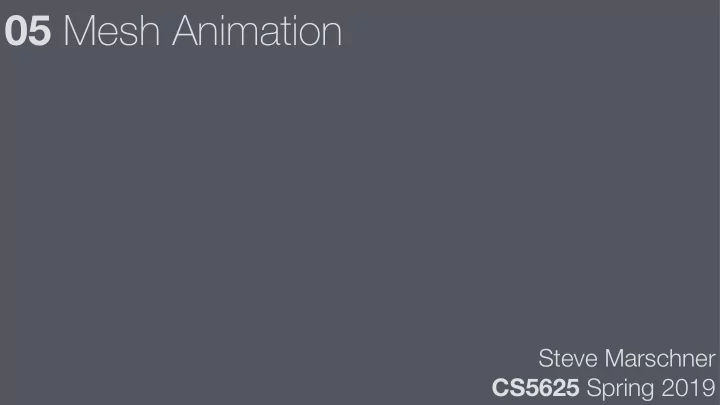

05 Mesh Animation Steve Marschner CS5625 Spring 2019
Basic surface deformation methods Blend shapes: make a mesh by combining several meshes Mesh skinning: deform a mesh based on an underlying skeleton Both use simple linear algebra • Easy to implement—first thing to try • Fast to run—used in games The simplest tools in the o ffl ine animation toolbox
Blend shapes Simply interpolate linearly among several key poses • Aka. blend shapes or morph targets [3D Studio Max example]
Blend shapes José Alves da Silva— Corlyorn Family (Vodafone campaign)
Blend shapes math Simple setup • User provides key shapes: a position for every control point in every shape - p ij for point i , shape j • Per frame: user provides a weight w j for each key shape - Must sum to 1.0 Computation of deformed shape X p 0 w j p ij i = j Works well for relatively small motions • Often used for for facial animation • Runs in real time; popular for games
P . Blair, Cartoon Animation .
Mesh skinning A simple way to deform a surface to follow a skeleton [Sébastien Dominé | NVIDIA]
H [Jacobson, SIGGRAPH 2014 course] w i T i define handles define weights apply transformations
Mesh skinning math: setup Surface has control points p i • Triangle vertices, spline control points, subdiv base vertices Each bone has a transformation matrix M j • Normally a rigid motion Every point–bone pair has a weight w ij • In practice only nonzero for small # of nearby bones • The weights are provided by the user Points are transformed by a blended transformation • Various ways to blend exist
Linear blend skinning Simplest mesh skinning method Deformed position of a point is a weighted sum • of the positions determined by each bone’s transform alone • weighted by that vertex’s weight for that bone X p 0 w ij M j p i i = [Lewis et al. SIGGRAPH 2000] j 0 1 @X w ij M j A p i = j
Linear blend skinning Simple and fast to compute • Can easily compute in a vertex shader Used heavily in games Has some issues with deformation quality • Watch near joints between very di ff erent transforms
Linear skinning: classic problems Surface collapses on the inside of bends and in the presence of strong twists • Average of two rotations is not a rotation! [Lewis et al. SG’00] [Mohr & Gleicher SG’03]
Dual quaternion skinning Root problem of LBS artifacts: linear blend of rigid motions is not rigid Blending quaternions is better • proper spherical interpolation is hard with multiple weights • just blending and renormalizing works OK However, blending rotation and rotation center separately performs poorly [Kavan et al. SG ’08] Figure 6: Artifacts produced by blending rotations with respect to the origin (left) are even worse than those of linear blend skinning (right).
Dual quaternions Combines quaternions (1, i, j, k) with dual numbers (1, ε ) • resulting system has 8 dimensions: 1, i, j, k, ε , ε i, ε j, ε k • write it as sum of two quaternions: ˆ q = q 0 + ✏ q ✏ Unit dual quaternions • inherits quaternion constraint: k q 0 k = 1 • adds one more constraint: q 0 · q ✏ = 0 • a 6D manifold embedded in 8D • represents rigid motions with nice properties Skinning by blending dual quaternions works well
[Kavan et al. SG ’08] Figure 14: Comparison of linear (left) and dual quaternion (right) blending. Dual quaternions preserve rigidity of input transforma- tions and therefore avoid skin collapsing artifacts. [Kavan, SG’14 course] Rest pose Dual quaternion skinning Linear blend skinning
Recommend
More recommend